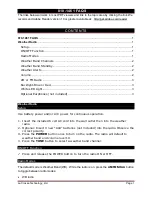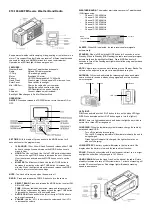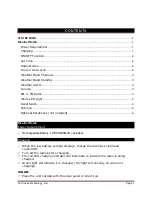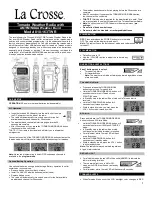
1-1
SECTION 1. WEATHER STATION DESCRIPTION AND INSTALLATION
The weather station is designed to collect weather data for calculation of evapotranspiration of the
surrounding area where it is located. The selection of the weather station site is important; a poor site
will give non representative measurements which result in inacurate ET values.
1.1 STANDARD SENSORS
Sensors with preassigned channels include:
•
Wind speed
•
Wind direction
•
Temperature
•
Solar radiation
•
Rainfall
•
Relative humidity
1.2 WEATHER STATION SITE SELECTION
1.
Trees, buildings, or other structures can
greatly influence wind speed and direction
observations. As a rule of thumb, a
structure will disturb the air flow an upwind
distance of about twice the height of the
structure, a downwind distance of about six
times the height of the structure, and a
vertical distance of up to twice the height of
the structure (Figure 1.2-1).
2.
The station should be located over the most
typical type of turf used on the course. It
must not be placed over a concrete slab,
parking lot, or unplanted earth. This allows
the temperature and humidity readings to
closely correspond with that of the turf the
ET value is to represent.
3.
The radiation shield that covers the probe
provides protection from direct sunlight and
rain. The shield does not protect against
irrigation water should any be sprayed up
into the plates.
NOTE: The weather station should not be
located where sprinklers spray water into
the rain bucket or onto the radiation shield.
4.
The Solar Radiation Sensor should be
located so it is not shadowed by
surrounding objects.
5.
The weather station should not be placed at
the top of a knoll or mound, but in an area
lower than the surrounding hills if possible.
This lowers the probability of it being struck
by lightning.
6.
During installation, extreme care should be
taken to avoid touching or coming near
power lines. Contact could be fatal. Do not
locate the station in the vicinity of overhead
power lines.
7.
The distance from the weather station to the
central computer determines the gage of
the wire and the baud rate used. In Table
1.2-1, wire gage, distance, and baud rate
can be determined.
TABLE 1.2-1 Approximate Range, Miles
Data Rate 19 Gage
24 Gage
26 Gage
bps
Miles
Miles
Miles
9,600
5.0
4.0
2.5
1,200
6.5
5.0
3.5
Summary of Contents for NW8002
Page 12: ...1 7 FIGURE 1 4 1 NW8002 Cement Base FIGURE 1 4 2 NW8002 Tower with Tilt Base...
Page 34: ...A 1 APPENDIX A SENSOR SCHEMATICS...
Page 35: ...APPENDIX A SENSOR SCHEMATICS A 2...
Page 36: ...APPENDIX A SENSOR SCHEMATICS A 3...
Page 37: ...APPENDIX A SENSOR SCHEMATICS A 4...







































